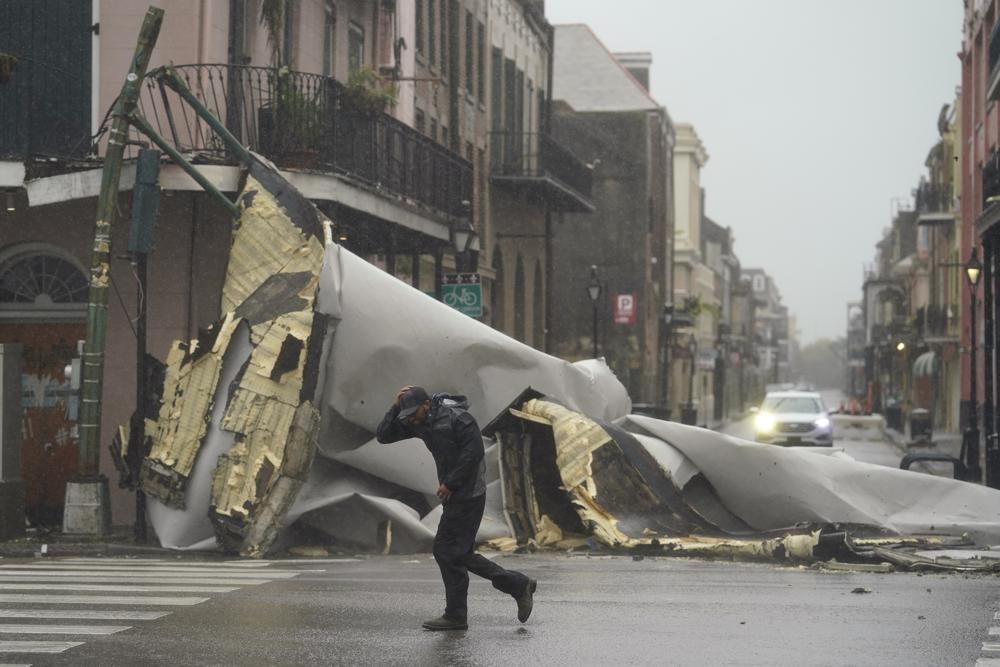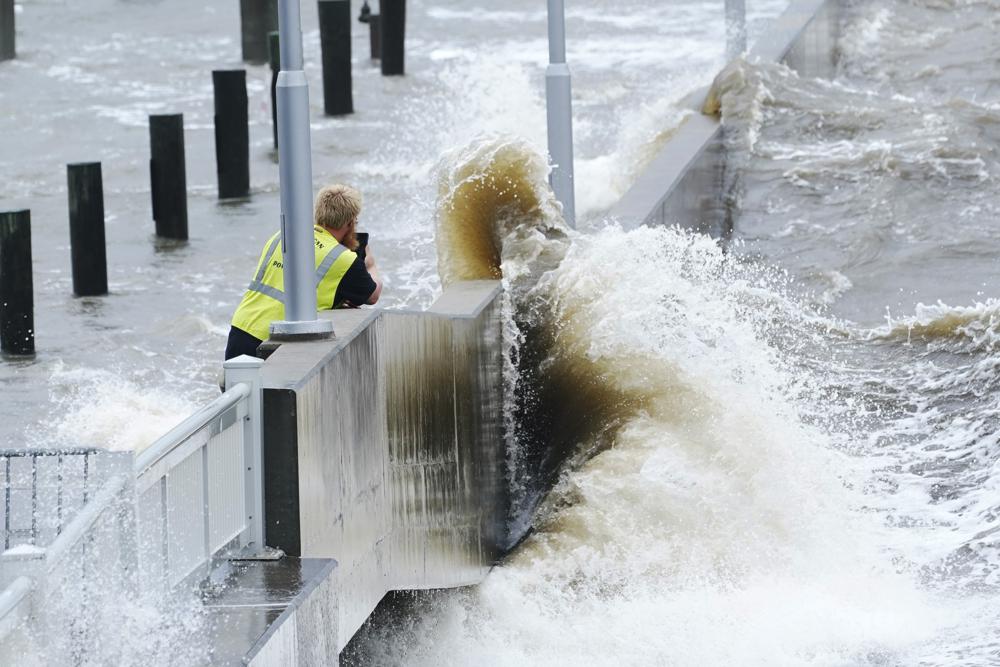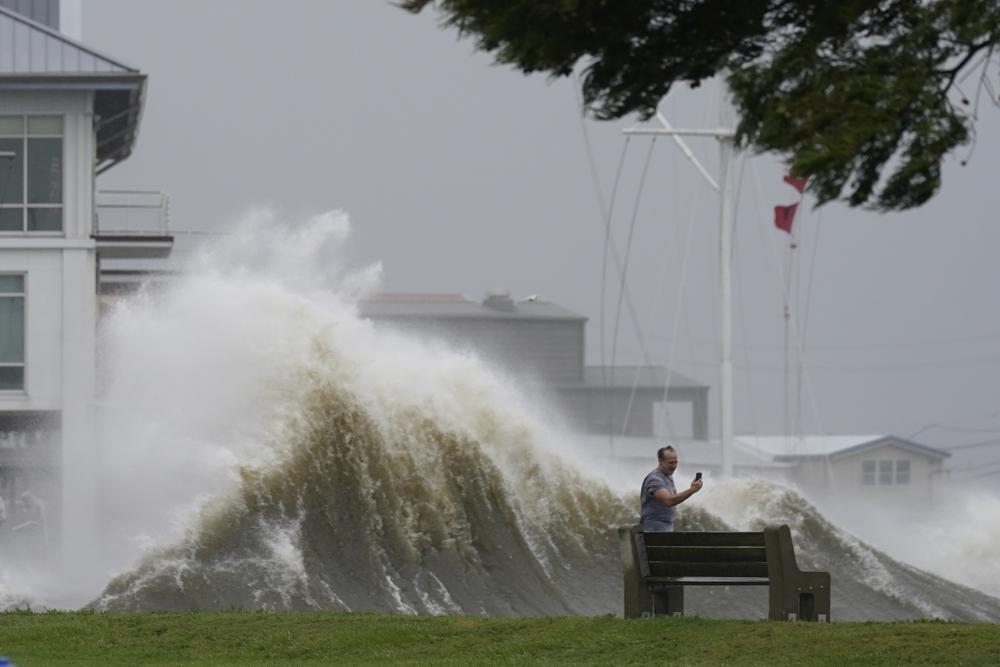Hurricane Ida lashes Louisiana, all of New Orleans without power
The Category 4 storm hit on the same date Hurricane Katrina ravaged Louisiana and Mississippi 16 years earlier
Hurricane Ida blasted ashore Sunday as one of the most powerful storms ever to hit the U.S., blowing off roofs and reversing the flow of the Mississippi River as it rushed from the Louisiana coast toward New Orleans and one of the nation’s most important industrial corridors.
The Category 4 storm hit on the same date Hurricane Katrina ravaged Louisiana and Mississippi 16 years earlier, coming ashore about 45 miles (72 kilometers) west of where Category 3 Katrina first struck land. Ida’s 150-mph (230 kph) winds tied it for the fifth-strongest hurricane to ever hit the mainland U.S. It dropped hours later to a Category 3 storm with maximum winds of 120 mph (193 kph) as it crawled inland, its eye 25 miles (40 kilometers) west-southwest of New Orleans.
The rising ocean swamped the barrier island of Grand Isle as landfall came just to the west at Port Fourchon. Ida made a second landfall about two hours later near Galliano. The hurricane was churning through the far southern Louisiana wetlands, with the more than 2 million people living in and around New Orleans and Baton Rouge under threat.
“This is going to be much stronger than we usually see and, quite frankly, if you had to draw up the worst possible path for a hurricane in Louisiana, it would be something very, very close to what we’re seeing,” Gov. John Bel Edwards told The Associated Press.
People in Louisiana woke up to a monster storm after Ida’s top winds grew by 45 mph (72 kph) in five hours as the hurricane moved through some of the warmest ocean water in the world in the northern Gulf of Mexico.

Wind tore at awnings, water spilled out of Lake Ponchartrain in New Orleans, and boats broke loose from their moorings. The Coast Guard office in New Orleans received more than a dozen reports of breakaway barges, said Petty Officer Gabriel Wisdom. In Lafitte about 35 miles (56 km) south of New Orleans, a loose barge struck a bridge, according to Jefferson Parish officials.ADVERTISEMENT
Elsewhere, engineers detected a “negative flow” on the Mississippi River as a result of storm surge, U.S. Army Corps of Engineers spokesman Ricky Boyette said.
Edwards said he watched a live video feed from around Port Fourchon as Ida came ashore.
“The storm surge is just tremendous. We can see the roofs have been blown off of the port buildings in many places,” Edwards told the AP.
Officials said Ida’s swift intensification from a few thunderstorms to a massive hurricane in just three days left no time to organize a mandatory evacuation of New Orleans’ 390,000 residents. Mayor LaToya Cantrell urged residents remaining in the city on Sunday to “hunker down.”
Marco Apostolico said he felt confident riding out the storm at his home in New Orleans’ Lower 9th Ward, one of the city’s hardest-hit neighborhoods when levees failed and released a torrent of floodwater during Katrina.
His home was among those rebuilt with the help of actor Brad Pitt to withstand hurricane-force winds. But the memory of Katrina still hung over the latest storm.
“It’s obviously a lot of heavy feelings,” he said. “And yeah, potentially scary and dangerous.”
The region getting Ida’s worst includes petrochemical sites and major ports, which could sustain significant damage. It is also an area that is already reeling from a resurgence of COVID-19 infections due to low vaccination rates and the highly contagious delta variant.

New Orleans hospitals planned to ride out the storm with their beds nearly full, as similarly stressed hospitals elsewhere had little room for evacuated patients. And shelters for those fleeing their homes carried an added risk of becoming flashpoints for new infections.
Forecasters warned winds stronger than 115 mph (185 kph) threatened Houma, a city of 33,000 that supports oil platforms in the Gulf.
The hurricane was also threatening neighboring Mississippi, where Katrina demolished oceanfront homes. With Ida approaching, Claudette Jones evacuated her home east of Gulfport, Mississippi, as waves started pounding the shore.
“I’m praying I can go back to a normal home like I left,” she said. “That’s what I’m praying for. But I’m not sure at this point.”
Comparisons to the Aug. 29, 2005, landfall of Katrina weighed heavily on residents bracing for Ida. Katrina was blamed for 1,800 deaths as it caused levee breaches and catastrophic flooding in New Orleans. Ida’s hurricane-force winds stretched 50 miles (80 kilometers) from the storm’s eye, or about half the size of Katrina, and a New Orleans’ infrastructure official emphasized that the city is in a “very different place than it was 16 years ago.”
The levee system has been massively overhauled since Katrina, Ramsey Green, deputy chief administrative officer for infrastructure, said before the worst of the storm hit. While water may not penetrate levees, Green said if forecasts of up to 20 inches (50 centimeters) of rain prove true, the city’s underfunded and neglected network of pumps, underground pipes and surface canals likely won’t be able to keep up.
At least 619,000 customers were already without power Sunday after nightfall, according to PowerOutage.US, which tracks outages nationwide.

The Louisiana Department of Environmental Quality was in contact with more than 1,500 oil refineries, chemical plants and other sensitive facilities and will respond to any reported pollution leaks or petroleum spills, agency spokesman Greg Langley said. He said the agency would deploy three mobile air-monitoring laboratories after the storm passes to sample, analyze and report any threats to public health.
Louisiana’s 17 oil refineries account for nearly one-fifth of the U.S. refining capacity and its two liquefied natural gas export terminals ship about 55% of the nation’s total exports, according to the U.S. Energy Information Administration. Government statistics show that 95% of oil and gas production in the Gulf Coast region was shut down as Ida made landfall on Sunday, according to energy company S&P Global Platts.
Louisiana is also home to two nuclear power plants, one near New Orleans and another about 27 miles (about 43 kilometers) northwest of Baton Rouge.
President Joe Biden approved emergency declarations for Louisiana and Mississippi ahead of Ida’s arrival. He said Sunday the country was praying for the best for Louisiana and would put its “full might behind the rescue and recovery” effort once the storm passes.
Edwards warned his state to brace for potentially weeks of recovery.
“Many, many people are going to be tested in ways that we can only imagine today,” the governor told a news conference.
Have you subscribed to theGrio’s new podcast “Dear Culture”? Download our newest episodes now!
TheGrio is now on Apple TV, Amazon Fire, and Roku. Download theGrio today!
The post Hurricane Ida lashes Louisiana, all of New Orleans without power appeared first on TheGrio.
from TheGrio https://ift.tt/3jr94xN
No comments: